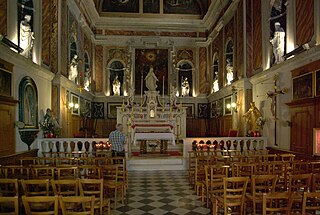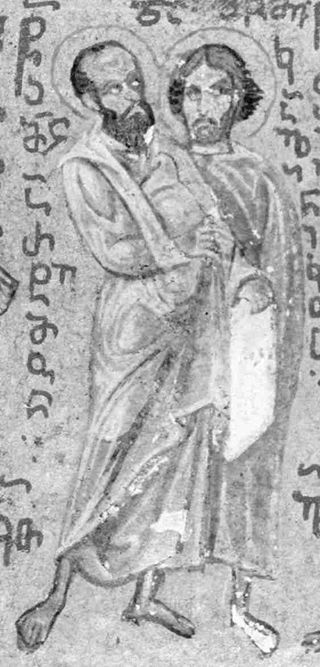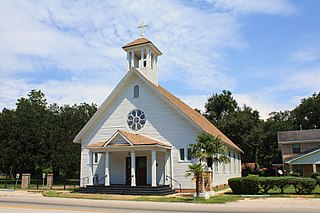Saint Ampelus (died 302) is a martyr venerated by the Eastern Orthodox and Roman Catholic churches on November 20. [1] He was killed by Romans with his companion, Gaius, during the reign of Diocletian. [2]

Saint Joseph Catholic Church in Hilo is a parish of the Roman Catholic Church of Hawaii in the United States. Located at 43 Kapiolani Street, 19°43′20″N155°5′25″W, in Hilo on the Big Island of Hawaii, the church falls under the jurisdiction of the Diocese of Honolulu and its bishop. It is named after Saint Joseph, foster father of Jesus. This parish operates the St. Joseph Junior and Senior High School and an elementary school.

Epiphania or Epiphaneia was a city in Cilicia Secunda, in Anatolia.

The Catholic Church in Monaco is part of the worldwide Catholic Church, under the spiritual leadership of the Pope in Rome.

The Roman Catholic Archdiocese of Sherbrooke is a Roman Catholic archdiocese that includes part of the civil province of Quebec and includes the suffragan dioceses of Nicolet and Saint-Hyacinthe. It is currently led by Luc Cyr.

Artemas of Lystra was an early Christian saint, who is mentioned in the New Testament. He is mentioned in Paul's Epistle to Titus. He is believed to have served as the Bishop of Lystra, and to have been one of the Seventy Disciples. He is a saint in the Eastern Orthodox Church and Roman Catholic Church.
The Eparchy of Saint Thomas the Apostle is a Chaldean Catholic diocese in Sydney, Australia, and is immediately subject to the Holy See.

The Eparchy of Saint Vladimir the Great of Paris is an eparchy of the Ukrainian Greek Catholic Church, a sui iuris church of the Roman Catholic Church. Its territory encompasses France, Belgium, Luxemburg, the Netherlands and Switzerland.
St. Vincent Ferrer High School is an independent, college-preparatory Roman Catholic high school for girls located on the Upper East Side of the Manhattan, in New York City, New York.

Saint Gregory's Catholic College in Odd Down, Bath, England is a Roman Catholic, co-educational secondary school with a sixth form. It was renamed from Saint Gregory's Comprehensive School, which opened in 1979. It teaches around 1000 pupils, its current head teacher is Melissa George.

Saint Patrick's Church is a Roman Catholic church located near St. Thomas Mount, in Chennai, India. From 1887, the church at the foot of St.Thomas Mount had been used as the Parish Church as it was convenient for the growing population.

Saint Francis Xavier Roman Catholic Church, also known as St. Francis Xavier Church, is a historic Roman Catholic church building in the Toulminville neighborhood of Mobile, Alabama, United States. It serves as the parish church for St. Francis Xavier Parish in the Roman Catholic Archdiocese of Mobile. St. Francis Xavier Parish was established in 1868. The vernacular style building was completed in 1916, replacing a previous structure destroyed in a hurricane. It was placed on the National Register of Historic Places on July 3, 1991, as part of the Historic Roman Catholic Properties in Mobile Multiple Property Submission.

Saints Peter and Paul Catholic Church is a Roman Catholic church in Honolulu, Hawaii. The church belongs to the East Honolulu vicariate of the Roman Catholic Diocese of Honolulu, and serves the Ala Moana, Ala Wai, Kapiolani, Kewalo, and McCully districts of the city.

The Cathedral of Saint Patrick and Saint Felim, also known as Cavan Cathedral, is a Roman Catholic cathedral located in Cavan, Ireland. It is the seat of the Bishop of Kilmore, and the mother church of the Roman Catholic Diocese of Kilmore.
St Edmund's Catholic School is a coeducational Roman Catholic secondary school, located in Portsmouth in the English county of Hampshire.
Saint John Houghton Catholic Voluntary Academy is a mixed Roman Catholic secondary school located in Kirk Hallam in the English county of Derbyshire. The school is named after Saint John Houghton, a Carthusian hermit and Catholic priest who was the first English Catholic martyr to die as a result of the Act of Supremacy by King Henry VIII of England.

Trinity Church is a Roman Catholic church in Halmstad in Sweden. It is part of Saint Mary's Roman Catholic Parish within the Catholic Diocese of Stockholm.

Saint Benedict's Catholic Church is a parish of the Roman Catholic Church in Honaunau, Hawaii. It was built between 1899 and 1902 under the direction of the Belgian Catholic missionary Father John Velghe, who then painted frescoes along the interior ceiling and walls. An untrained folk-artist, Fr. Velghe depicted various biblical scenes, such as Cain's murder of Abel, Jesus refusing the Devil, and the writing on the wall, as well as a vivid illustration of sinners in Hell. While the building itself is small and rectangular, Fr. Velghe painted Gothic vaults above the altar, creating the illusion of a European Gothic cathedral, inspired particularly by Burgos Cathedral. Several other priests learned from Velghe and went on to establish other 'painted churches', including Star of the Sea Painted Church, painted by Father Evarist Gielen.
St Bede's Catholic High School is a coeducational secondary school located in the Lytham area of Lytham St Annes in the English county of Lancashire.
Prymnessus or Prymnessos, or Prymnesus or Prymnesos (Πρύμνησος), or Prymnesia (Πρυμνησία) was a town of ancient Phrygia. Its site is located near Sülün in Asiatic Turkey.
Pedachtoë or Pedachthoe, also known as Heracleopolis or Herakleioupolis, was a town of ancient Pontus, inhabited during Roman and Byzantine times. It was assigned to the late Roman province of Armenia Prima, in which it became the seat of an archbishop. No longer a residential see, it remains a titular see of the Roman Catholic Church.